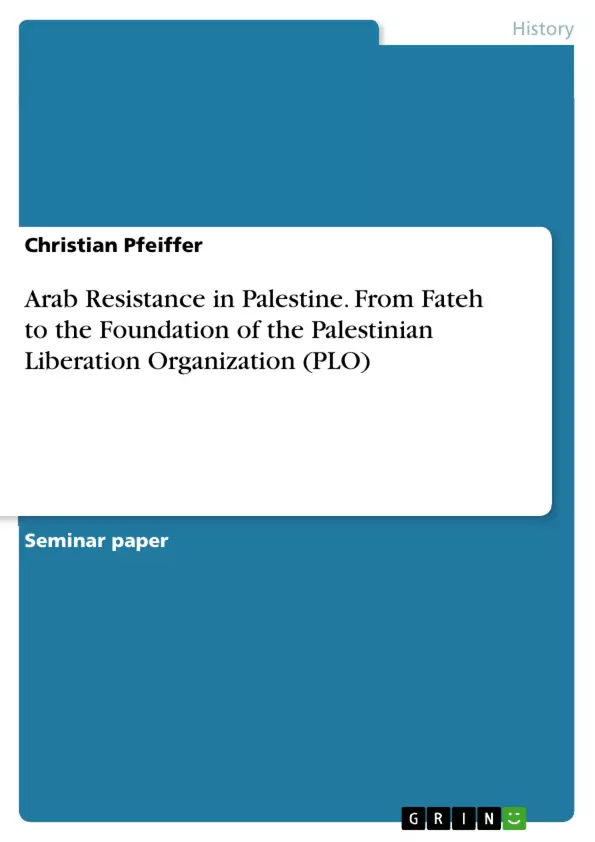The Middle East of the present-days would look different without the Palestinian Liberation Organization (PLO), the political and military arm of the Palestinians. Over decades the organization transformed itself from the home of groups consisting of terrorists and armed fighters to the political voice of all Palestinians.
Responsible for the efforts was the man who took over the PLO in 1969 and made it first the home for Arab terrorists and later to an organization to administer Palestine and to deal with the international parties concerned with the conflict in the Middle East: Peace-Nobel-Laureate Yasir Arafat. Decisive for the aggressive policies the PLO adopted in its first decade were the events surrounding its foundation and the takeover through Arafat and his Fateh organization.
This research paper is going to examine why and how the powerful PLO could emerge. It is looking at the roots of Palestinian nationalism after World War II and introducing Arafat’s Fateh movement. Afterwards it will take a close look to the foundation process of the PLO and its aims. The organization will be transformed in 1968 through Arafat. Hence the last chapter of this paper will deal with this issue.
This research paper is based on a comprehensive bibliography containing primary and secondary sources and a scientific article on the topic. As basic work the very detailed book of Helena Cobban, The Palestinian Liberation Organisation – People, Power, Politics, was used.
Table of Contents
- Introduction
- 1. The Roots of Palestinian Nationalism after the End of World War II
- 2. From Student Activists to Organized Fighters in the Fateh Movement
- 3. Uniting the Palestinians: The Foundation of the Palestinian Liberation Organization (PLO)
- 4. The Takeover of the PLO through the Fateh
- Conclusion
Objectives and Key Themes
This research paper examines the emergence of the Palestinian Liberation Organization (PLO), tracing its development from the roots of Palestinian nationalism after World War II to its foundation and subsequent takeover by Yasir Arafat and his Fatah movement.
- The rise of Palestinian nationalism after World War II
- The formation of the Fatah movement and its role in Palestinian resistance
- The establishment of the PLO and its initial aims
- The impact of Arafat's leadership on the PLO
- The evolution of the PLO from a terrorist organization to a political entity
Chapter Summaries
- Introduction: This chapter sets the stage for the paper by introducing the PLO and its historical significance in the Middle East. It highlights the role of Yasir Arafat and the Fatah movement in shaping the PLO's trajectory.
- 1. The Roots of Palestinian Nationalism after the End of World War II: This chapter explores the historical context of Palestinian nationalism, tracing its origins to the aftermath of World War II and the struggle over Palestine between Jewish Zionists and Arab Palestinians. It discusses the UN's decision to partition Palestine into two independent states and the subsequent Arab-Israeli war.
- 2. From Student Activists to Organized Fighters in the Fateh Movement: This chapter examines the rise of Palestinian nationalistic movements, focusing on the Fatah movement founded by Yasir Arafat. It describes Fatah's early activities and its emergence as a significant force in the Palestinian resistance.
- 3. Uniting the Palestinians: The Foundation of the Palestinian Liberation Organization (PLO): This chapter delves into the process of establishing the PLO as a unified organization representing Palestinian interests. It analyzes the PLO's initial objectives and its role in the evolving Palestinian struggle.
- 4. The Takeover of the PLO through the Fateh: This chapter focuses on the takeover of the PLO by Arafat and the Fatah movement in 1968. It examines the impact of this change on the organization's ideology, policies, and activities.
Keywords
The research paper revolves around the Palestinian Liberation Organization, Palestinian nationalism, the Fatah movement, Yasir Arafat, the Arab-Israeli conflict, and the history of the Middle East.
- Citar trabajo
- Christian Pfeiffer (Autor), 2005, Arab Resistance in Palestine. From Fateh to the Foundation of the Palestinian Liberation Organization (PLO), Múnich, GRIN Verlag, https://www.grin.com/document/43073



